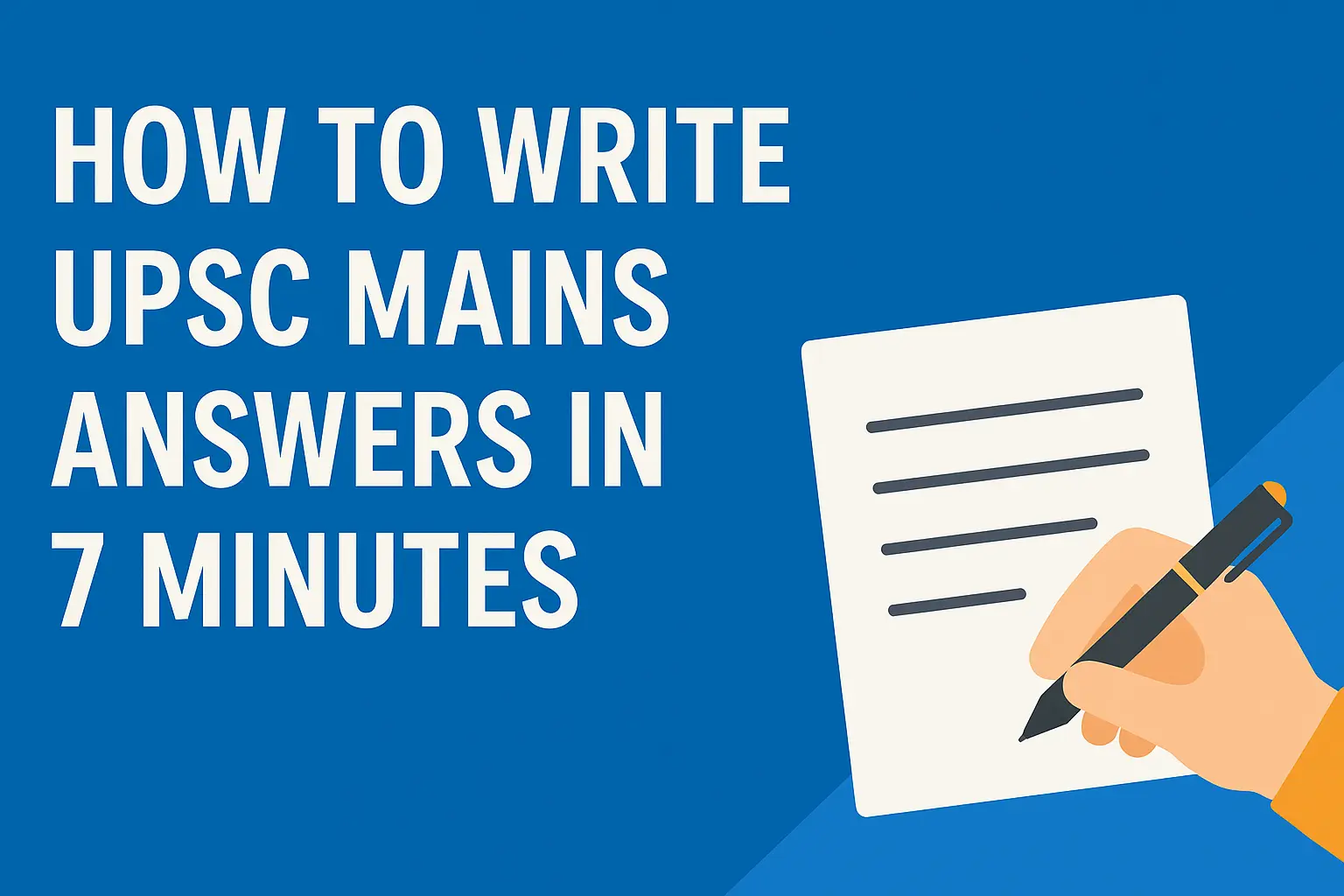
Three hours, twenty questions, one shot. That is the Civil Services Mains General Studies paper in plain numbers. The arithmetic gives you roughly nine minutes per answer for questions in upsc mains answer writing, but nine is a luxury you cannot afford if you want a safety buffer for the occasional curveball. Target seven minutes, bank two, and walk out without unfinished sub‑parts. The strategy below is practical, drawn from toppers’ answer sheets, evaluator feedback and relentless mock‑drill data.
Why Seven Minutes
Writing speed is not the main constraint in upsc mains answer writing, cognitive switching is. Each time you finish one answer and start the next you lose thirty to forty seconds in mental gear change. Over twenty questions that dead time eats about twelve minutes. Cut your working slot to seven minutes, reclaim the lost chunk, and finish before the final bell. Seven minutes is long enough to show depth and short enough to keep handwriting legible.
Groundwork Before the Exam : Answer writing strategy for UPSC mains
- Content Compression: Convert bulky notes into one‑page mind maps per topic. If you cannot capture an entire syllabus heading on a single sheet you will not recall it in seven minutes.
- Trigger Sheets: Maintain two pages of high‑yield data, one for statistics and schemes, one for constitutional articles, landmark cases, international indices and best practices. Revise them every Sunday.
- Directive Drill: Make a table of UPSC verbs (discuss, critically examine, evaluate, elucidate, substantiate) with their exact demand. Stick it above your desk and rehearse until automatic.
- 7‑6‑5 Regimen: Write one answer daily in seven minutes for the first month, six for the second, five for the third. When exam day arrives seven feels slow.
- Peer Review: Exchange copies with a serious peer and insist on harsh margin comments, no false praise.
- Wrist Endurance: Use a weighted pen or rough paper to strengthen grip muscles. Cramping steals minutes.
- Mock Papers: Sit in a wooden chair, no music, ceiling fan, 9 to 12 slot. Simulated discomfort pre‑empts surprises of upsc mains answer writing.
Best way to write upsc answers in Exam Hall
You enter with only three assets: a clear head, a strict schedule and a skeleton approach rehearsed a hundred times.
| Step | Action | Time |
|---|---|---|
| 1 | Read the question, underline directive and keywords | 30 s |
| 2 | Break the demand into sub‑parts, jot tiny arrows in the margin | 15 s |
| 3 | Frame the answer (Intro, three to four body headings, Conclusion), decide any diagram | 45 s |
| 4 | Write a two‑line introduction that defines the core term or hooks with a fact | 60 s |
| 5 | Draft the body, use sub‑headings, bullet points and examples | 4 min |
| 6 | Sketch a labelled diagram, flowchart or table if it adds value | 30 s |
| 7 | Conclude with a way forward or balanced judgment | 30 s |
| 8 | Circle action verbs and statistics | 10 s |
Total: 7 minutes
How to write answers in UPSC mains
The examiner awards marks for breadth, balance and logical flow in upsc mains answer writing. Start with a brief definition or context, then open the body with dimensions arranged clockwise in your mental map.
For a question on water pollution your headings could be
(i) Social impact on health,
(ii) Economic cost to agriculture and industry,
(iii) Institutional gaps in regulation,
(iv) Political friction in interstate river management,
(v) Cultural attitudes toward waste disposal.
This order feels intuitive and avoids frantic back‑and‑forth on the page.
Special Frames
• SPICE: Social, Political, Institutional, Cultural, Economic
• DIME: Direct, Indirect, Moral, External (security analysis)
• PRAISE: Principles, Repercussions, Alternatives, Stakeholders, Implementation, Evaluation (ethics)
Memorise three or four such frames; they save thinking time when adrenaline is pumping.
Handling Optional Subject Answers
Optionals differ in upsc mains answer writing. The examiner is a specialist who looks for depth over spread. Spend the first minute fixing a precise thesis statement. Use domain terminology, cite theories or scholars, draw diagrams where the discipline expects them, yet keep the seven‑minute cap. For Geography draw a quick world map, for Sociology reference Weber or Merton, for Public Administration quote recent committee reports. Depth signals command, breadth is a bonus.
Quality Versus Quantity
Do not chase three hundred words. Marks correlate with relevance, not volume. Aim for 180 to 200 words, split into an intro of about 30, body of 120 and conclusion of 30 to 40. Each bullet must carry one idea, one fact, one example. If a bullet needs two lines you are probably combining ideas that should be separate. If the question has two directives allocate equal words or the examiner will penalise imbalance.
Language and Presentation
Write in simple, formal prose. Avoid flowery adjectives, rhetorical questions and preachy tone. Keep sentences short, subject before verb, verb before object. Underline keywords but never entire sentences. Use modest diagrams, straight lines only, labels outside shapes. Number sub‑headings consistently. Leave half‑line spacing between points for readability. Stick to one ink colour unless the rule book allows two. Legibility beats artistry every single time.
GS Mains Answer Writing Tips
• Fact Sandwich: Begin and end each bullet with data, wrap analysis in the middle, because evaluators scan first and last words.
• Red Flag Rule: If you are guessing, leave it out. Wrong data angers checkers and burns trust.
• Mnemonic Seeds: Plant short memory aids in your notebooks like SAFEST for disaster response steps. They save recall time under pressure.
Common Pitfalls in upsc answer writing during mains exam
- Over‑planning: Spending two minutes on the rough outline eats writing time.
- Data Dumping: Listing random facts without linkage to the directive screams panic.
- Generic Conclusions: Each answer must end specific to the question, not with a copy‑paste quotation.
- Handwriting Collapse: Practise long mocks using the same pen you will carry to the hall.
- Ignoring Sub‑parts: UPSC often nests (a) and (b). Miss one and the examiner slashes marks.
- Clock Blindness: Wear a watch. Do not rely on invigilator calls.
Mindset on D‑Day of UPSC Mains Exam
Treat the bell like a railway timetable. When the invigilator says thirty minutes left you should be on question seventeen. If you are late compress upcoming answers by dropping a diagram, not by deleting a sub‑part. If you finish early add one crisp fact or underline a missing keyword, avoid ornamental fluff. Accept that one answer will be average; do not let it poison the rest. Focus on the next question, not the previous mistake
Conclusion
Writing a competent UPSC Mains answer writing in seven minutes is a muscle‑memory task. Build the muscle through timed drills, tight content capsules and ruthless self‑review. On exam day trust the drill. Seven minutes is your insurance against the unexpected. Choose discipline now or carry regret for a year.
FAQ for UPSC Mains Answer Writing
1. Why UPSC Mains Answer writing is crucial ?
Because UPSC Mains tests not just knowledge but your ability to express it under time pressure. Without consistent practice, even well-prepared candidates struggle to complete the paper or structure answers effectively.
2. What is the ideal time to write one UPSC Mains answer?
Aim to finish each answer in 7 minutes. This allows enough time for depth, structure and legibility while banking extra minutes to handle tough or multi-part questions.
3. How can I improve my answer writing skills for UPSC?
Use structured strategies like daily timed practice (7-6-5 method), peer-reviewed feedback, mind maps for content compression, and mock tests under real exam conditions.
4. What common mistakes reduce marks in UPSC answer writing?
Over-planning, ignoring sub-parts, dumping irrelevant data, generic conclusions and poor handwriting are common errors that directly impact your score.
5. How should answers be structured in the GS Mains papers?
Start with a short intro, follow with 3 to 4 body headings in logical order, include diagrams or flowcharts if needed, and conclude with a specific and balanced insight.
Read Also : IAS power vs IPS power

Leave a Reply